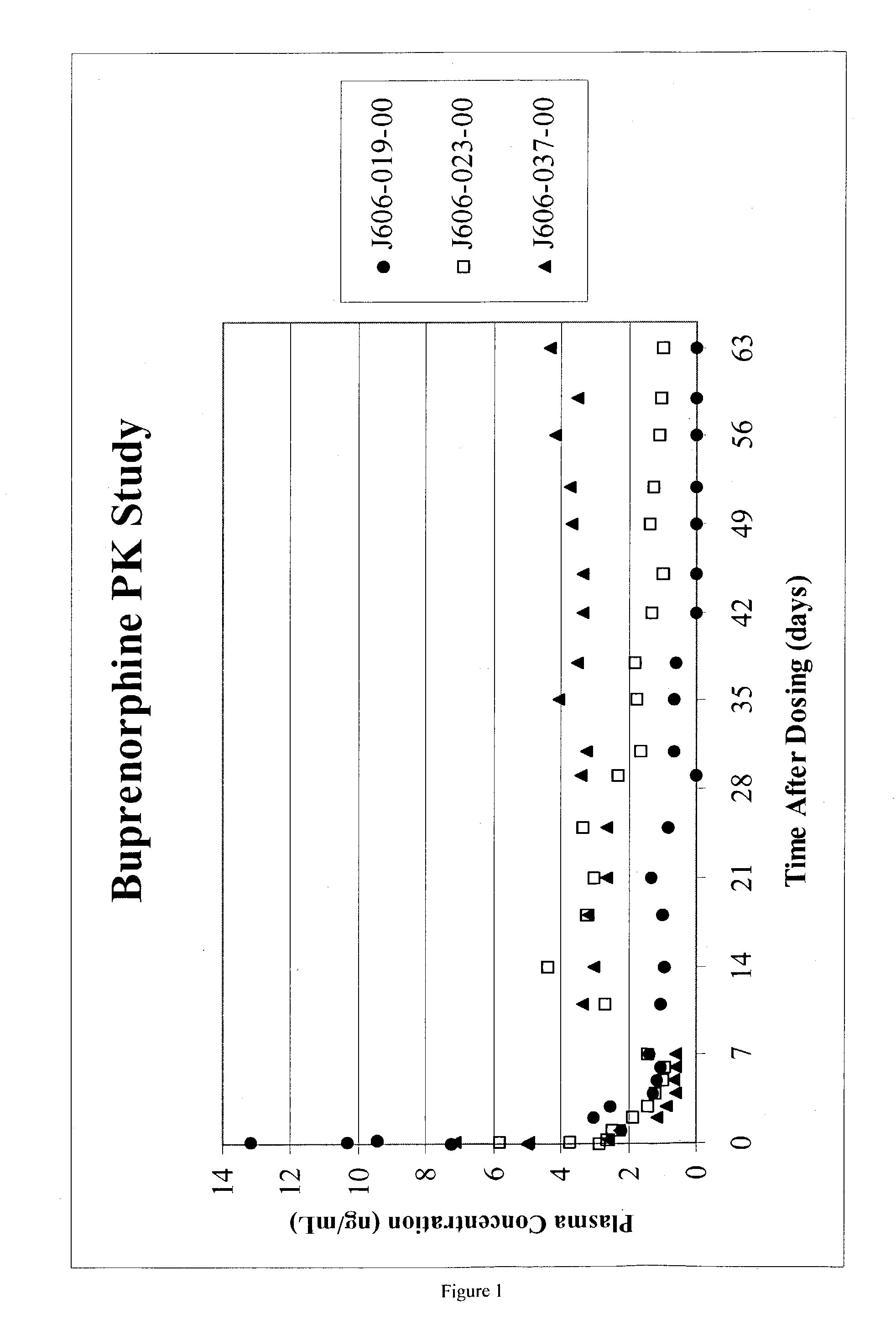Injectable opioid partial agonist or opioid antagonist microparticle compositions and their use in reducing consumption of abused substances
a technology of partial agonists and opioid antagonists, which is applied in the direction of drug compositions, biocide, prosthesis, etc., can solve the problems of lack of retention and relapse, inability to maintain the therapeutic routine, and continuous and relatively unavailing efforts to reduce the number of scheduled substances and alcohol users
- Summary
- Abstract
- Description
- Claims
- Application Information
AI Technical Summary
Benefits of technology
Problems solved by technology
Method used
Image
Examples
example 1
General Method of Preparation of Naltrexone Microparticles
[0032] The following example is exemplary of the method of preparation generally, where the individual conditions are indicated in the following table. The chemical components are prepared as follows. Poly(D,L-lactide) is dissolved in ethyl acetate with stirring. The drug is added to the polymer solution and dissolved with stirring. Poly(vinyl alcohol) ("PVA") is dissolved in sterile water by slowly adding the PVA to the stirred water while heating the sterile water to a temperature of 90.degree. C. After complete dissolution of the PVA, the solution is allowed to cool and filtered through a 0.2 .mu.m filter, which is followed by adding ethyl acetate to the PVA solution at 3 wt. %.
[0033] The system employed is substantially as described above, where for a batch of 15 g, using polymer having a viscosity of 1.07 dL / g and a theoretical drug concentration of 50% (relative to the combined weight of polymer and drug), the tubing em...
example 2
Preparation of Buprenorphine (Free-base) Microparticles
[0041] A typical 10 g batch size was prepared as follows:
[0042] A 7% polymer solution was prepared by dissolving 5 g polymer in 66.2 g ethyl acetate. To this solution, 5 g of buprenorphine was added. This mixture (the dispersed phase, DP) was stirred until the drug dissolved.
[0043] A solution of 2 wt % poly(vinyl alcohol) was prepared in water. Sufficient ethyl acetate was added to this solution in order that the final concentration of ethyl acetate was 2.5 wt %. This solution (the continuous phase, CP) is called the CP phase.
[0044] The DP was pumped into a mixer at 27.2 g / min. Using separate tubing, the CP was pumped into the mixer as well at a flow rate of 124 g / min. The two solutions were kept separate until immediately before mixing took place inside the continuous-flow mixer head. Mixing was performed at a stir speed of 870 rpm. The emulsion coming out of the mixer was extracted using water that was pumped at a rate of 2050...
example 3
Preparation of Buprenorphine (Free-base) Microparticles
[0045] A typical 20 g batch size was prepared as follows:
[0046] A 4.1% polymer solution was prepared by dissolving 6.3 g polymer in 146.6 g ethyl acetate. To this solution, 11.6 g of buprenorphine was added. This mixture (the dispersed phase, DP) was stirred until the drug dissolved.
[0047] A solution of 1 wt % poly(vinyl alcohol) was prepared in water. Sufficient ethyl acetate was added to this solution in order that the final concentration of ethyl acetate was 2.5 wt %. This solution (the continuous phase, CP) is called the CP phase.
[0048] The DP was pumped into a mixer at 25.9 g / min. Using separate tubing, the CP was pumped into the mixer as well at a flow rate of 127.2 g / min. The two solutions were kept separate until immediately before mixing took place inside the continuous-flow mixer head. Mixing was performed at a stir speed of 726 rpm. The emulsion coming out of the mixer was extracted using water that was pumped at a ra...
PUM
| Property | Measurement | Unit |
|---|---|---|
| diameter | aaaaa | aaaaa |
| diameter | aaaaa | aaaaa |
| diameter | aaaaa | aaaaa |
Abstract
Description
Claims
Application Information
 Login to View More
Login to View More - R&D
- Intellectual Property
- Life Sciences
- Materials
- Tech Scout
- Unparalleled Data Quality
- Higher Quality Content
- 60% Fewer Hallucinations
Browse by: Latest US Patents, China's latest patents, Technical Efficacy Thesaurus, Application Domain, Technology Topic, Popular Technical Reports.
© 2025 PatSnap. All rights reserved.Legal|Privacy policy|Modern Slavery Act Transparency Statement|Sitemap|About US| Contact US: help@patsnap.com

